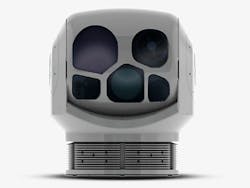Navy chooses electro-optical and thermal-imaging sensors from FLIR for patrol boat nighttime operations
Officials of the Naval Surface Warfare Center in Crane, Ind., announced a $10.7 million order to FLIR on Friday for the Patrol Boat Electro-Optics System (PB-EOS). The primary mission of the PB-EOS is to provide enhanced visual imagery to augment existing electronic sensors.
FLIR experts are designing the PB-EOS to enhance low-visibility and night navigation; maritime interception; coastal observation and surveillance; insertion and extraction operations; visit, board, search, and seizure operations; combat search and rescue; identification friend or foe; real-time situational awareness and threat warning; reconnaissance and surveillance; and documenting navigational hazards.
This order is a modification to a $49.9 million five-year contract the Navy awarded to FLIR in September 2013 for as many as 142 of the PB-EOS electro-optical sensor payloads for small maritime vessels. The order increases the number of PB-EOS sensors from 142 to 168, including cable kits.
The primary mission of the PB-EOS is to provide enhanced visual imagery to augment existing electronic sensors that will enhance low-visibility and night navigation, maritime interception, coastal observation and surveillance, insertion and extraction operations, combat search and rescue, identification, real-time situational awareness and threat warning, reconnaissance and surveillance, documenting navigational hazards, as well as visit, board, search and seizure operations.
The PB-EOS is a variant of the FLIR SeaFLIR 280-HD maritime imaging system, which provides critical capability to enhance navigation, intelligence, surveillance, and reconnaissance.
SeaFLIR 280-HD is a high performance maritime imaging system designed to identify and track smugglers, terrorists, or any other threat during the day and at night, and on rough seas. SeaFLIR 280-HD uses powerful optics and thermal imaging sensors for daylight and low-light camera imaging for long-range vessel detection, identification, and threat assessment.
The system weighs less than 55 pounds, and offers 982-millimeter focal length camera on a stabilized platform. It has a multi-field-of-view spotter scope; split screen; picture-in-picture; medium-wave infrared (MWIR) thermal camera; and short-wave infrared (SWIR) camera to see thorough mist, smog, smoke, and haze.
The SeaFLIR 280-HD has laser designation capability, and offers as many as three cameras that operate simultaneously, as many as three laser payloads, and high-precision inertial measurement unit.
On this PB-EOS order, FLIR will do the work in North Billerica, Mass., and should be finished by October 2019. For more information contact FLIR Systems online at www.flir.com, or the Naval Surface Warfare Center Crane at www.navsea.navy.mil/Home/Warfare-Centers/NSWC-Crane.
Ready to make a purchase? Search the Military & Aerospace Electronics Buyer's Guide for companies, new products, press releases, and videos
